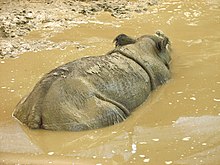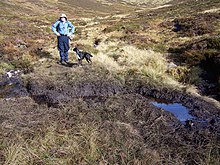Wallowing

Wallowing in animals is comfort behaviour during which an animal rolls about or lies in mud, water or snow.[1] Some definitions include rolling about in dust,[2] however, in ethology this is usually referred to as dust bathing. Wallowing is often combined with other behaviours to fulfil its purpose; for example, elephants will often blow dirt over themselves after wallowing to create a thicker "coating", or pigs will allow the mud to dry before rubbing themselves on a tree or rock to remove ectoparasites stuck in the mud.
Functions[edit]

Many functions of wallowing have been proposed although not all have been tested by rigorous scientific investigation. Proposed functions include:
- Thermoregulation – domestic pigs (Sus scrofa),[3] great Indian rhinoceros (Rhinoceros unicornis),[4] warthogs (Phacochoerus aethiopicus),[5] elephants (family Elephantidae)[6]
- Providing a sunscreen – pigs,[7] warthogs,[5] elephants[6]
- Male-male conflict social behaviour – elk (Cervus elaphus), European bison (Bison bonasus),[8][9] deer[10]
- Removal of ectoparasites – white rhinoceros (Ceratotherium simum),[11] American bison (Bison bison),[12] warthog[13]
- Social cohesion – American bison[14]
- Relief from moulting – European bison,[15] elephant seals (genus Mirounga)
- Relief from biting insects – tamaraw (Bubalus mindorensis),[16] American bison,[17][18] tapirs (Tapirus bairdii),[19] warthog,[5] elephants[6]
- Play in young animals – American bison[20]
- Skin maintenance (preventing dehydration) – hippopotamus (Hippopotamus amphibius)[21]
- Camouflage – warthog[5]
- Scent-marking – Some animals urinate in a wallow before entering and rolling in it, presumably as a form of scent-marking behaviour[22][23]
- Skin microbiome selection – Horses [24]
Domestic pigs[edit]

Pigs lack functional sweat glands and are almost incapable of panting. To thermoregulate, they rely on wallowing in water or mud to cool the body. Adult pigs under natural or free-range conditions can often be seen to wallow when air temperature exceeds 20 °C. Mud is the preferred substrate; after wallowing, the wet mud provides a cooling, and probably protecting, layer on the body. When pigs enter a wallow, they normally dig and root in the mud before entering with the fore-body first. They then wriggle the body back and forth, and rub their faces in the mud so all of the body surface is covered. Before they leave the wallow, they often shake their heads and body, often finishing with rubbing against a tree or a stone next to the wallow. When indoors and hot, domestic pigs often attempt to wallow on wet floor surfaces and in the dunging areas.[25]
Although temperature regulation seems to be the main motivation for wallowing in pigs, they will still wallow in colder weather. While many have suggested that pigs wallow in mud because of a lack of sweat glands, pigs and other wallowing animals may have not evolved functional sweat glands because wallowing was a part of their behavioural repertoire.[7]
Pigs are genetically related to animals such as hippopotamus and whales. It has been argued that wallowing behaviour and the desire to be in shallow, murky water could have been a step to the evolution of whales and other marine mammals from land-dwelling mammals.[7]
Sumatran rhinoceros[edit]

The Sumatran rhino (Dicerorhinus Sumatrensis) spends a large part of its day wallowing. When mud holes are unavailable, the rhino will deepen puddles with its feet and horns. One 20-month study of wallowing behaviour found they will visit no more than three wallows at any given time. After two to 12 weeks using a particular wallow, the rhino will abandon it. Typically, the rhino will wallow around midday for two to three hours at a time before foraging for food. Although in zoos the Sumatran rhino has been observed wallowing less than 45 minutes a day, the study of wild animals found 80–300 minutes per day spent in wallows. Captive individuals deprived of adequate wallowing have quickly developed broken and inflamed skins, suppurations, eye problems, inflamed nails, hair loss and have eventually died.[26]
Deer[edit]

Many deer perform wallowing, creating wallow sites in wet depressions in the ground, eventually forming quite large sites (2–3 m across and up to 1 m deep). However, it has been claimed that only some species of deer wallow; red deer (Cervus elaphus) particularly like to wallow but fallow deer (Dama dama), for example, do not wallow. Even within the red deer species, there is variation between sub-species and breeds in wallowing behaviour. For example, although wapiti do wallow, they and crossbreds are less inclined to wallow than European red deer.[27]
See also[edit]
References[edit]
- ^ The Free Dictionary. "Wallowing". Retrieved April 15, 2013.
- ^ Dictionary.com. "Wallowing". Retrieved April 15, 2013.
- ^ Vestergaard, K.S. and Bjerg, B., (1996). Wallowing behavior in fattening pigs, In: I.J.H. Duncan, T.M. Widowski and D.B. Haley (Eds). Proc. Thirtieth International Cong. International Soc. Appl. Ethol., The Colonel K.L. Cambell Centre for the Study of Animal Welfare, Ontario, Canada. p. 66.
- ^ Pal, B.C. and Bhattacharyya, A., (1986). Wallowing behavior and wallows used by great Indian one-horned Rhinoceros at Garumara and Jaldapara wildlife sanctuaries, West Bengal, India. Proc. Zoologic. Soc., Calcutta, 35: 79-83
- ^ a b c d Maryland Zoo in Baltimore. "Common Warthog Phacochoerus africanus". Retrieved April 16, 2013.
- ^ a b c Klappenbach, L. "Elephants". About.Com. Retrieved April 16, 2013.
- ^ a b c Bracke, M. (2011). Review of wallowing in pigs: Description of the behaviour and its motivational basis. Applied Animal Behaviour Science, 132: 1-13 doi:10.1016/j.applanim.2011.01.002
- ^ Struhsaker, T. (1967). Behavior of elk (Cervus canadensis) during the rut.[dead link] Z. Tierpsychol., 24: 80-114
- ^ Geist, V. (1982). Adaptive behavioral strategies, In: J.W. Thomas and D.E. Toweill, (Eds). Elk of North America. Stackpole Books, Harrisburg, Pennsylvania. pp. 219-278
- ^ Zhi-Tao, L., Jan-Hua, D., Yan-Ling, S., Zhi-Gao, Z. and Qiong, Z. (2007). Wallowing behavior of Hainan Eld’s deer Cervus eldi hainanus male during the rut and its function in reproduction. Current Zoology (formerly Acta Zoologica Sinica), 53(3): 417-424 [1]
- ^ "White rhinoceros". 2012. Archived from the original on March 4, 2016. Retrieved April 15, 2013.
- ^ Mooring, M.S. and Samuel, W.M., (1998). Tick defense strategies in bison: the role of grooming and hair coat. Behaviour, 135: 693-718
- ^ Natur Spot. "Warthog (Phacochoerus aethiopicus) - Long-legged, fast and not at all defenceless". Archived from the original on March 4, 2016. Retrieved April 15, 2013.
- ^ Reinhardt, V., (1985). Quantitative analysis of wallowing in a confined bison herd. Acta Theriol., 30: 149-156
- ^ Cabon-Racyznska, R.M., Krasinska, Z.A., Krasinska, J.M. and Wojcik, J.M. (1987). Rhythm of daily activity and behavior of European bison in the Bialowieze Forest in the period without snow cover. Acta Theriol., 32: 335-372
- ^ Momongan, V.G. and Walde, G.I., (1993). Behavior of the endangered tamaraw (Bubalus mindorensis Heude) in captivity. Asia Life Sci. 2: 241-250
- ^ McMillan, B.R., Cottam, M.R. and Kaufman, D.W. (2000). Wallowing behavior of American bison (Bos bison) in Tallgrass Prairie: An examination of alternate explanations. The American Midland Naturalist, 144:X [2] Archived 2016-02-25 at the Wayback Machine
- ^ Soper, J.D., (1941). History, range, and home life of the northern bison. Ecology Monographs, 11: 347-412
- ^ Morris, D. (2005). "Face to face with big nose" (PDF). BBC Wildlife. Archived from the original (PDF) on January 12, 2012. Retrieved April 15, 2013.
- ^ McHugh, T.S., (1958). Social behavior of the American buffalo (Bison bison bison). Zoologica, 4: 1-40
- ^ Klappenbach, L. "Hippopotamus-Hippopotamus amphibius". About.com. Archived from the original on April 15, 2013. Retrieved April 16, 2013.
- ^ Valerius Geist (1998). Deer of the World: Their Evolution, Behaviour, and Ecology. Stackpole Books. ISBN 978-0-8117-0496-0.
- ^ Keck, S. "Elk (Cervus Canadensis)". Archived from the original on June 17, 2011. Retrieved April 15, 2013.
- ^ Scott, Julia (2014-05-22). "My No-Soap, No-Shampoo, Bacteria-Rich Hygiene Experiment". The New York Times. ISSN 0362-4331. Retrieved 2020-08-18.
- ^ "The ethology of domestic animals". 2001. Retrieved April 15, 2013.
- ^ Ng, J., S.C.; Zainal-Zahari, Z.; Nordin, A. (2001). "Wallows and wallow utilization of the Sumatran rhinoceros (Dicerorhinus Sumatrensis) in a natural enclosure in Sungai Dusun Wildlife Reserve, Selangor, Malaysia". Journal of Wildlife and Parks. 19: 7–12.
- ^ Deer Industry New Zealand. "Wallowing". Retrieved April 15, 2013.
External links[edit]
- BBC Nature - Elephants videos, news and facts - Video of elephants wallowing
